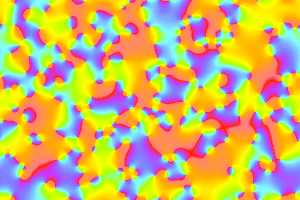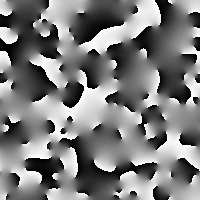Eric Weeks
- personal pages -
computer-generated picturesLiquid-crystal-like cellular automata |
weeks/physics.emory.edu |
Eric Weeks
- personal pages -
computer-generated picturesLiquid-crystal-like cellular automata |
weeks/physics.emory.edu |
![]()
![[colorful
splotches]](stuff/lcca12.gif)
![]()
This is a cellular automata, simulating a nematic liquid crystal.
At each lattice site, imagine you have a little arrow pointing in
some direction. Each arrow wants to point in the same direction as its
neighbors. Start off with all the arrows pointing in random directions,
then try to adjust all the arrows so that they are pointing like
their neighbors. Mostly this works; occasionally you can't satisfy all
of your neighbors at the same time, and you get cusps.
In the picture above, the color corresponds to the direction that the
arrow is pointing at each lattice site. At the cusps (defects),
you get a pinwheel of the different colors around a single point.
Note, in a real nematic liquid crystal, the "arrows" are actually
double-headed arrows, that is, arrows want to point parallel to
the neighboring arrows, but the direction is unimportant other
than being parallel. (Arrows pointing straight right are happy
being next to arrows pointing straight left, that is, since they are
double-headed arrows, there is no distinction between a right-pointing
arrow and a left-pointing arrow.)
One additional cheat -- I start with random arrows. This generally
results in a certain density of defects. I decided this was too high
a density for pretty pictures, so after a while of computing I expand
the array by a factor of 2 or 3 in both directions, then compute
a little while longer (to help the new result reach a steady state).
Thus some of the pictures shown have different densities of defects.
The picture was made using PPM
and converted to GIF.
I've often been accused of liking black & white pictures too much,
and told to make more color pictures. Well, yeah, color
pictures are nice. But you can do some really cool things with
black and white! The picture above-right is the same algorithm as
discussed above, just using the color to indicate direction. The boundaries
between black and white are the places where the arrows are pointing
straight right (an arbitrary definition) and the ends of those boundaries
are where the defects are, where the colors around a single point are
everything from black to white.
Click here to see some more black and white pictures made using
the same algorithm, with the only change being the way the colors
are mapped to black and white:
![[download]](stuff/knobload.gif) Click here to download software -- "gcc -o lcca lcca.c -lm" to compile.
The software is fairly clear, but I am not going to try to explain it
here -- if you have questions on how to use it, you can email me if you
want.
Click here to download software -- "gcc -o lcca lcca.c -lm" to compile.
The software is fairly clear, but I am not going to try to explain it
here -- if you have questions on how to use it, you can email me if you
want.
![]()
Other pictures






![]()
Links...
Current address:
Eric R. Weeks
weeks/physics.emory.edu
Department of Physics
Emory University
Atlanta, GA 30322-2430